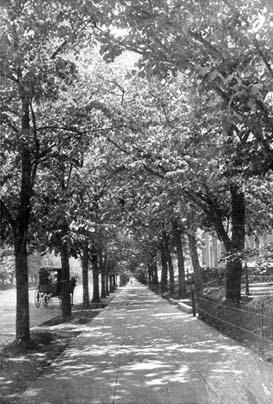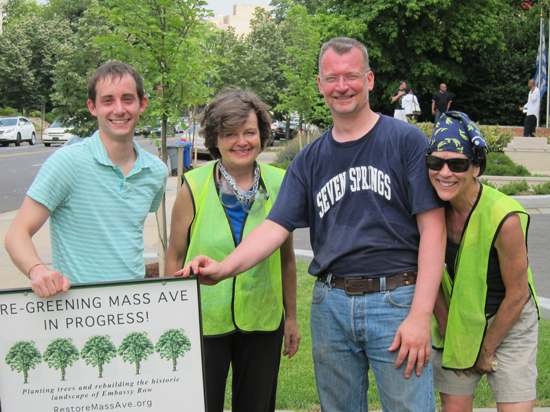Watershed Wednesday: Restore Mass Ave (Washington, D.C.)
Restore Mass Ave encourages local property owners to take care of the city trees in their neighborhood.
The above 1913 photograph depicts rows of American lindens planted along Washington D.C.’s Massachusetts Avenue, west of Dupont Circle. The “double rows” of trees were planted in the 1880s, but many disappeared as the street was developed, new embassies were built, and utility lines installed. As a street that has historically been an international relations hub (it is home to major embassies), the loss of trees along Massachusetts Avenue seemed to represent the worldwide preference of commercialism over nature.

(Image courtesy Restore Mass Ave/Washingtoniana MLK Library)
Today, the climate has shifted, and politicians jump at the chance to get their photo taken in front of a newly planted tree; but long before the diplomats grabbed their shovels (and press staff), Deborah Shapley was walking up and down Massachusetts Avenue, knocking on her neighbors’ doors, and asking them how far their hoses could stretch to water parched trees in the sidewalk.
Washington’s D.C.'s Department of Transportation's Urban Forestry Administration has taken the important step of planting trees along streets throughout the city, but it did not have the resources to water them. For young trees, lack of water lowers their chances of survival in Washington’s hot summers. Instead of complaining, Deborah encouraged her neighbors to take on the responsibility of watering their nearest city sidewalk tree as if it were their own.
“I started Restore Mass.Ave to be a model of how to get local property owners excited about taking care of the city trees near them.”
But convincing property owners to take care of a tree that isn’t technically in their yard is not so easy.
“People tend not to care about the landscape that is more than a house or two away,” explains Deborah. “So the cry for them to take care of trees beyond a certain distance, that’s just not practical to them.”
But since Deborah began Restore Mass Ave in 2007, more and more residents and embassies along the street have come to understand that these trees are dually beautifying their community and helping to absorb stormwater runoff.

(Image courtesy Restore Mass Ave)
In addition to caring for the 100 sidewalk trees installed by the city, Restore Mass has worked with Casey Trees to plant 125 new trees since 2007. Most of the 225 total trees are large shade trees, which absorb stormwater and lessen pressure on the neighborhood's combined sewer system.
Like most of downtown Washington D.C., Massachusetts Avenue has a combined sewer system (css), which collects water from both stormwater runoff and household’s sanitary sewage. The CSS conveys this to treatment plants to be cleaned before it flows into the Chesapeake Bay.
But during heavy rain events, the combined sewer system often overflows; the stormwater and sanitary wastes flow directly into the Anacostia or Potomac River. This can cause an excess of bacteria and other pollutants in Washington D.C.’s tributaries, rivers and the Chesapeake Bay.
While it is always important to find ways to decrease the amount of stormwater runoff flowing into storm drains, it is particularly crucial in neighborhoods with combined sewer overflows (roughly one-third of the District of Columbia).
“The city is under requirements from the EPA to rebuild the underground tunnels and pipes” associated with the combined overflow system, explains Deborah. “They’re only able to do a certain amount per year of underground infrastructure. But large trees naturally conduct precipitation down into the soil and lowers the burden the underground pipes.”’
Stormwater will instead be absorbed by trees, and help to recharge the groundwater so more plants can grow.
“If you have a continuous line of shade trees alongside of a gutter, less water flows into that storm drain, and less water is barreling around in the tunnels of the combined stormwater system,” Deborah says.
While trees help to absorb stormwater during rain events, they do need to be watered when it is not raining. Droughts and heat waves make it difficult for young trees to survive on their own. Luckily, Restore Mass Ave’s volunteers, known as “Treekeepers,” make sure care is given to every sidewalk tree.
Since roughly one-third of Mass Ave properties are foreign-owned, the organization works with embassies to plant trees on their grounds.
While it was once typical for embassies’ groundskeepers to maintain flowers the colors of the nations’ flags, it is now popular for embassies to also maintain the surrounding trees. Governments relate the activity to their climate change agendas. Groundskeepers become, in effect, "Treekeepers."
“They have a sense of ownership that they didn’t have before,” says Deborah. “When you give people who care for plants the chance to grow nearby sidewalk trees, they are delighted.”
As Restore Mass Ave encourages private homeowners and embassy staffs to care for trees in public space, the sense of shared community and stewardship multiplies.
“As in many neighborhoods, we found that the embassies don’t often talk to each other, but when you point out the common trees, and you engage all the staff, it becomes their common garden,” explains Deborah.
While Restore Mass Ave may have found a way to create a sense of an international environmental stewardship, Deborah, founder and president of the all-volunteer organization, concedes that the nonprofit would like to expand its influence, but not its area.
“The idea is to not take over a bigger and bigger area, but to get other people to start their own groups, such as Restore Georgia Avenue or Restore Connecticut Avenue. Only as more people here understand the importance and fun of growing trees, will DC become the ‘City of Trees’ as it was known a century ago."

(Image courtesy Restore Mass Ave)
Get involved
For more information on how you can get involved with Restore Mass Ave or start your own “Restore” on your street, visit the Restore Mass Ave Volunteer page.
Restore Mass Ave is trying to spread the word, via their Tree Care Blog (http://blog.restoremassave.org) and their Facebook and Twitter (#restoremassave).

Comments
I just wanted to say thank you for all of the work you have been doing. The city has removed many dead trees; thank you for planting new ones. Thank you for helping to protect the environment and the Bay, making our neighborhoods look more inviting and attractive, and providing the world with cleaner oxygen! Thanks again.
Thank you!
Your comment has been received. Before it can be published, the comment will be reviewed by our team to ensure it adheres with our rules of engagement.
Back to recent stories